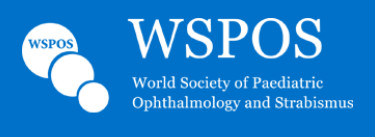Education
Case Report: Case 19
Case Presenters
Dr. Daniel P. Dominguez graduated from the Buenos Aires Medicine University (UBA), Argentina in 1986 and completed his residency in ophthalmology at the Parmenio Piñero Hospital, Buenos Aires, Argentina 1990. He is a specialist in ophthalmology at the UBA since 1992, in addition to being a member of the Latin American Council of Strabismus (CLADE) and Argentine Strabismus Center (CAE; 1989 – present). Dr. Dominguez has a Masters in Strabismus and other Ocular Motilities Diseases (USAL Buenos Aires, 1997 – 2000), in addition to being a Fellow at The Smith Kettelwell Eye Research Institue (SKERI – 1993). He is now the Head of Ophthalmology, Parmenio Piñero Hospital, Buenos Aires, Argentina (2000 – present) & is also a professor of the UBA. Dr. Dominguez was a President of the Argentine Strabismus Centre 2000 – 2002. He has acquired his Doctoral Thesis from the Buenos Aires Medicine University in 2010 & is now the President of Resident Accreditation Commission in Ophthalmology at the Argentine Society Ophthalmology (SAO) (2019 – present).
Dr. Daniel P. Dominguez has sent us Case 19
Status: CASE CLOSED
Members’ Responses:
1) When our members were asked ‘what according to you is the best treatment for this patient?’
22.92% said they’d use Prims, 16.67% opted for Orthoptic Treatment, 58.33% said they’d go for Surgery and the remaining 2.08% said they’d prefer Occlusion at this juncture.
2) When they were asked ‘If you decided to perform a surgery, would you perform it based on?’
While 63.83% would base it on their clinical findings, the remaining 36.17% would do so, based on torsion evaluation.
3) When our members were asked ‘Whether they feel a Double Maddox Rod Test is useful to measure mild torsional deviation?’
80.85% answered Yes & 19.15% said No.
.
Experts Opinion
1) Can IV Nerve Palsy coexist without torsional defect in the paretic eye?
2) Does the Hering Law apply only to Horizontal and Vertical muscles? Or can it be used for Obliques muscles too?
3) Could you suggest any preoperatory test to prevent Torsional Diplopia?
Wei Zhang

Dr. Wei Zhang is currently the Head of Division of Pediatric Ophthalmology and Strabismus at Tianjin
Eye Hospital and Professor at Tianjin Medical University and Nankai University in China. Dr. Wei Zhang
serves currently as the President of Chinese Association for Pediatric Ophthalmology and Strabismus. He
has authored over 60 publications and 3 book-chapters. Dr. Wei Zhang serves as editorial members of 5
journals and member of International Strabismus Association. He has been bestowed Chinese
Ophthalmology Society Award in 2018. He has expertise in the diagnosis and treatment of strabismus,
and neuro-ophthalmology. His research focuses on electrophysiology, eye movement and stereopsis,
visual function and development in infants and children.
1) When our Experts were asked ‘What according to you is the best treatment for this patient’?
Dr. Zhang opted for Surgery. His reasoning is as follows: If at the beginning of complaint of vertical diplopia due to motor vehicle accident, prism, occlusion even orthoptic treatment could be considered. But now after 4 years, the patient still presents head tilt and vertical deviation in primary position is 10 PD whereas 20 PD in lateral gaze, it is a good indication for IO weakening surgery rather than conservative treatment.
2) When asked ‘If you decided to perform a surgery, would you perform it based on?’ Dr. Zhang replied as follows:
If I decide to perform surgery, I would base it on clinical findings such as ocular movement, vertical deviation prism diopters and torsion evaluation to decide which muscle should be performed and how many millimeters should be done
3) When our Experts were asked ‘Whether they feel a Double Maddox Rod Test is useful to measure mild torsional deviation?’
Dr. Zhang answered ‘Yes’; since LE shows mild extorsion and RHT is 20 PD on down left gaze, double Maddox rod test measurement is valuable when deciding surgical plan.
4) Can IV Nerve Palsy coexist without torsional defect in the paretic eye?
IV nerve palsy is the most common extraocular muscle palsy which is responsible for cyclo-vertical strabismus, diplopia and abnormal head posture. It can be acquired and usually a result of closed head trauma.
From the history of motor vehicle accident and coma, bilateral IV nerve palsy (perhaps asymmetric bilateral IV nerve palsy) could be considered at the beginning of history. Now after 4 years, the patient presents head tilt instead of chin down and no torsional diplopia (If double Maddox rod test performed, it would be better), whereas vertical deviation and right IOOA are significant, therefor I support the right IOOA weakening procedure done by Dr. Domínguez.
It is very important to differentiate IV nerve palsy from ocular tilt reaction(OTR). Usually the characteristics of OTR include conjugate torsion, vertical deviation decreasing in supine position, abnormal head posture. Because the patient did no present significant conjugate torsion and no examination result of vertical deviation in supine position, OTR is not considered at present.
IV nerve palsy can coexist without obvious torsional defect in the paretic eye if judged by fundus photograph because the result of fundus photograph can be impacted by patient head position, fixation and the torsion can be transfer to contralateral eye.
5) Does the Hering Law apply only to Horizontal and Vertical muscles? Or can it be used for Obliques muscles too?
Hering law can apply to oblique muscle even palpebralis.
6) Could you suggest any preoperatory test to prevent Torsional Diplopia?
I suggest prim adaption test before surgery to learn of patient response.
Stephen Kraft

Dr. Stephen P. Kraft, MD, FRCSC is staff ophthalmologist in the Departments of Ophthalmology and
Vision Sciences at Toronto’s Hospital for Sick Children, practising paediatric ophthalmology with a
specialty interest in strabismus, and at the University Health Network in Toronto, specializing in adult
strabismus and botulinum treatment of dystonia and strabismus. He is Professor in the Department of
Ophthalmology and Vision Sciences in the Faculty of Medicine at the University of Toronto, Toronto,
Canada. His research interests include clinical and surgical advances in strabismus, diagnosis of
amblyopia, botulinum toxin therapy of strabismus and neurologic disorders, and children’s vision
development. Dr. Kraft has published 108 peer-reviewed papers and 44 book chapters, and he has
given over 380 presentations all over the world. Dr. Kraft has trained 166 part-time and full-time fellows
in strabismus and paediatric ophthalmology from over 40 countries, and he has been a visiting professor
in 47 institutions.
I will respond to the questions by first summarizing my understanding of the case and the issues that arose. And then I will address your questions in Slides 9, 10, and 11.
The issues in this case are as follows:
1. The patient had characteristic findings of a right 4th nerve (superior oblique) paresis (SOP), with an incomitant right hypertropia (RHT) that was worse on left gaze and on right forced head tilt, along with overaction of the right inferior oblique (RIO). The patient adopted the expected compensatory head posture (CHP) of a left head tilt, which was adopted to control the RHT, not for torsion.
2. The torsion shown was normotorsion of the right fundus and mild extorsion of the left fundus. To me, this was entirely compatible with a right SOP, irrespective of which eye showed the torsion on fundus photos. In these cases, I am more interested in the presence of torsion in either eye, less so on exactly which eye shows the torsion. I see many cases of unilateral SOP in which the torsion shows up in the contralateral eye when you do the fundus check or when you photograph the fundi.
3. The preoperative problem was the head tilt due to the RHT, associated with the RIO overaction. So I agree with the plan of weakening the right inferior oblique (RIO).
4. The surgery has been successful in eliminating the CHP, as the vertical has been reduced to a tiny RH in primary position. The vertical has also been reduced to a phoria in the left gaze fields, suggesting that the surgeon achieved a nice large field of binocular single vision (BSV).
5. The torsion I see after surgery shows, as noted in the comment, a mild intorsion of the right eye. This is expected! The RIO weakening (an extorter of the eye) has altered the in that eye from normotorsion pre-op to a slight intorsion. There is extorsion of the left eye post-op –But that is probably a secondary phenomenon from the induced intorsion of the right eye, seen when the right eye fixates and forces the left into a relative extorsion position. I have seen this in many unilateral SOP cases, and does not, in my opinion, implicate a bilateral SOP. That is not as all consistent with the post-op versions and measurements.
6. From the information post-op he is not complaining of either vertical or torsional diplopia, even though there is residual extorsion in the left eye. This is also expected, as he had no torsional diplopia pre-op. In my experience, non-strabismic patients can have up to 6 degrees of extorsion that can be fused by cyclofusion (from studies on SOP and torsion that we published in Toronto many years ago). A patient with SOP can gain even more flexible cyclofusion amplitudes with time, so I am not surprised he is not bothered by cyclodiplopia in this post-op situation.
So to answer the questions on Slides 9-11:
SLIDE 9:
Addressing the differential diagnosis:
1. I do not believe this is a bilateral SOP – the torsion left over is mild and the eye movements and measurements do not suggest a contralateral SOP.
2. I do not believe this is an ocular tilt reaction (OTR). The head posture was solved by the surgery, and the torsion can be explained by the pre-op and post-op comparisons – as I noted above. With an OTR there is usually a head tilt posture in the same direction as the torsion – that does not apply here!
3. I also do not believe there are two diagnoses here. Everything can be explained by the right SOP, with the surgical treatment chosen being quite appropriate.
SLIDE 10:
1. Best treatment: None at all. The CHP is solved, there is an excellent alignment result, and from the notes the patient has no diplopia, either vertical or torsional.
2. In cases of SOP I would definitely include the clinical findings and the amount of torsion in deciding what procedure to do. You have to decide if the problem can be solved by correcting any horizontal and vertical heterotropias alone, in which case the torsion may be controlled afterward. On the other hand, if the torsion is going to prevent fusion post-op when the other components are solved, then it also has to be addressed. In this case, there is no further surgery indicated at all in this situation: I would treat the patient, not the fundus torsion!
3. I agree that in cases where torsion has to be quantitated, that the Double Maddox Rod (DMR) is a useful test. If one has to measure the torsion in SOP it must be done in the downgaze position, as well as in primary position. We showed in our studies that the downgaze torsion measurement with DMR is more sensitive in separating unilateral SOP from bilateral SOP than DMR in primary position, and DMR overall was more sensitive than the Bagolini lenses. Finally, if the surgeon has to know if correcting the torsion will be required along with addressing the vertical or horizontal tropias, the best test is a synoptophore (amblyoscope) evaluation, as one can correct the horizontal and vertical deviations, and see if torsion is controlled. If correcting the first two components does not allow fusion, then one can immediately determine how much torsion has to be corrected to allow fusion. These data are important in surgical planning in SOP cases.
SLIDE 11:
1. In my experience, it is very rare not to find at least a small amount of torsion in a patient with a newly acquired or congenital unilateral SOP. However, after many years, there can be a spread of comitance of the SOP such that the torsion may no longer be measured or seen on fundus check. I find that the presence of torsion is determined by the presence of oblique muscle dysfunction (IO overaction and/or SO underaction). If either has resolved with time then the associated torsion could be undetectable, leaving just the vertical tropia manifesting with vertical diplopia.
2. Yes – Hering’s Law can apply to oblique muscles. I believe it is related to the nerve circuits through the utricular apparatus –such that there can be conjugate torsion (“cycloversion”) in the two eyes in SOP. A good example is the post-op torsional findings in this case (intorsion of the right eye, forcing extorsion of the left eye when the right eye fixates).
3. To reduce the risk of post-op torsional diplopia in SOP, one has to do a careful assessment of torsion pre-op, as we discussed above. I ask my orthoptist to do a synoptophore exam (see above) to determine the amount of torsion that is present, and to determine if it has to be corrected to gain stable fusion when the other components of the strabismus are corrected. That is the best pre-op guide to know if one has to address the torsion to prevent persisting or unexpected cyclodiplopia afterward.
Kyle Arnoldi-Jolley

Kyle Arnoldi-Jolley is an Asst. Professor, Dept. of Ophthalmology, University at Buffalo Jacob’s School of
Medicine, in addition to being the Chief Orthoptist, Ross Eye Institute; Program Director, REI Orthoptic
Fellowship Program. She is also the Editor-in-Chief, Journal of Binocular Vision & Ocular Motility & the
American Representative to the International Orthoptic Association (IOA) Council of Management.
What is the most likely diagnosis?
Several possible diagnoses come to mind when reviewing this patient’s exam, including the options listed on Slide 9. But there are some pieces of information missing in the pre-op exam that prevent me from identifying the most likely diagnosis. The need for these results becomes clear in the discussion of each possible diagnosis below.
1. How much is “mild” cyclotropia? How was this measured?
2. How was the absence of torsional diplopia verified pre-operatively?
3. Was the patient able to fuse with offset of the vertical deviation with prisms or synoptophore?
4. Is the gait “instability” still present? Or was it only present in the immediate interval post-coma? Are there any other signs or symptoms of vestibular dysfunction?
5. Was the upright-supine test done?
6. Were old photos investigated for possible longstanding head posture?
7. Which is the dominant eye preferred for fixation?
8. Does he have a small foveal suppression scotoma in his non-dominant eye?
9. At what point post-MVA in 2016 were these pre-operative measurements taken?
Were vertical fusional measurements taken, either pre- or post-op?
Asymmetric (vs. Masked) Bilateral IV nerve palsy
In my experience, most bilateral asymmetric IV nerve palsies are revealed by a reversal of the hypertropia in the field of the contralateral IO muscle, if not on the 3-step test. We do not see that in this case. Nor do we see reversal of the hyper in any field post-operatively, which further argues against this diagnosis. However, I cannot rule out “masked” bilateral without knowing how much torsion was present in primary and in down gaze pre-operatively. If this is an acquired unilateral CN IV, with 10 prism diopters of hypertropia in primary, I would have expected at least 5 degrees of excyclotropia. And this patient should have had torsional diplopia in addition to the vertical at least in forced primary position. Therefore, I think this diagnosis is unlikely.
Ocular Tilt Reaction (OTR)
The pre-op fundus photos appear to show significant excyclotropia OS and mild incyclotropia OD. Regardless of the positive 3-step test results, this type of bilateral conjugate cyclotropia is evidence of OTR. The difficulty walking may be further evidence, but more details on this would be helpful. The fact that his head posture is still present in the pre-op pictures of the diagnostic positions of gaze, when presumably he was being encouraged to straighten his head, and the fact that his body posture in the full-face picture is also tilted (one shoulder higher than the other) suggests that either the deviation is long-standing (see next diagnosis) or this is due to OTR. The increased excyclotropia after weakening the RIO also supports OTR, if the OD is the dominant eye in this patient. But without an upright-supine test or other test of vestibular eye movements such as dynamic visual acuity, I cannot be certain how much, if any of this patient’s signs and symptoms may be due to OTR.
Congenital CN IV “palsy” (unilateral or bilateral)
Just because the vertical diplopia is new following head trauma doesn’t mean that the deviation is acquired secondary to the trauma. I have cared for several patients with known longstanding deviations who developed diplopia after head trauma, usually with no change in the deviation. Congenital CN IV “palsies” often have cyclotropia, but the ratio of prism diopters of vertical misalignment to degrees of cyclotropia is low1 and these cases almost never appreciate torsional diplopia. They are also more likely to show fundus torsion in the fellow eye than those with acquired CN IV palsy. Therefore it would be possible to have fundus torsion as in this case yet be asymptomatic. And because many of these congenital “palsies” may actually be due to orbital or tendon anomalies, dysinnervation syndrome, absent SO muscles, and significant compensatory adaptations of the recti and the orbital pulley system, – the clinical presentation does not always fit with the classic acquired CN IV palsy. This patient does not appear to have significant facial asymmetry, which argues against congenital CN IV. However, post-operatively he appears to fuse up to 7 prism diopters of right hyper according to the measurements! This indicates increased vertical fusional amplitudes, which is a sign of long-standing or congenital vertical misalignment.
Central Loss of Fusion
Any time I am referred a patient with a history of “severe” head trauma and coma, I must rule out central loss of fusion (CLF). It is not common, but it is also easily diagnosed on a synoptophore and will help the patient to form realistic expectations for treatment. CLF can present in a couple of different ways. Some patients retain the ability for sensory fusion, but have lost fusional vergence. This group will have manifest or intermittent strabismus of a small to moderate variable angle, often normal versions and constant diplopia. They will demonstrate fusion and even stereopsis briefly and intermittently with offset of their deviation. But the slightest shift in gaze can result in the return of small angle strabismus with diplopia. CLF can also manifest as constant diplopia in spite of excellent eye alignment. When images are projected onto corresponding retinal points, they are not fused. Occasionally, the image from the non-dominant eye will appear to move or be difficult to localize in space relative to the fixation target. These patients may have diplopia, but be unable to tell you where the second image is, behaving as if they have lost all cortical visual correspondence.
In this patient, I don’t have any strong evidence that CLF is present in addition to his strabismus. The absence of diplopia post-op seems to indicate no loss of fusion. However, I have no information on his pre-operative fusion potential and/or the presence of a suppression scotoma, so it cannot be ruled out.
What is the best treatment for this patient?
Slide 7 tells us that this patient has no vertical or torsional diplopia in primary position post-operatively. If he is asymptomatic in downgaze (distance and near) as well, then I would not recommend any further treatment at this time, in spite of the fact that he has significant fundus torsion. If he is symptomatic, I would need to know exactly what is bothering him before I could recommend a treatment.
If you decided to perform surgery, what would the surgery be based upon?
My first thought is that I would choose neither of the options given. I would base it on his symptoms. If he was bothered by torsional diplopia, I would perform a synoptophore exam to determine exactly how much torsion needs to be corrected to allow fusion. I would not recommend basing surgery on double Maddox rod or fundus torsion measurements as both of these are highly dissociating. They are very good for revealing the full amount of objective cyclotropia present, but do not account for the effects of fusion (sensory and motor), or suppression in those without bi-foveal fusion, in “fusion-friendly” visual environments. Operating for the full amount may lead to unnecessary surgery or over-correction.
If he had diplopia or visual confusion but was unsure whether there was a torsional component, I would check this by adding vertical and/or horizontal prism until he was able to fuse a light source at distance. I often do this using a red filter over the dominant eye in a darkened room. If I could achieve fusion under these conditions with prism, then I would change the target to a line of letters and ask if he is still able to fuse comfortably through the same prism with the room lights on. I use a line of letters 2-3 lines larger than his visual threshold. If he is symptomatic viewing letters in a lit room through the prism, then torsion may be an issue that needs to be addressed surgically.
If a synoptophore is available, it may be used instead of a light and prisms for the same purpose. Using Grade II fusion targets, particularly the house image (because of the horizontal and vertical lines), with the synoptophore arms set at the subjective angle, cyclotropia significant enough to obstruct fusion will be revealed.
Do you feel a double Maddox rod (DMR) test is useful in mild cyclotropia?
Yes, it can be, if the test is done correctly. I perform the DMR test with the room lights off, minimizing visual clues to orientation. If I know which is the involved eye at this point in the exam, I will put the red rod over the involved eye, whether or not it happens to be the dominant eye. If I don’t know yet which eye is involved, I will either use two red rods, or do the test twice, once with the red over the OD and once with the red over the OS, and compare. Mistakenly placing the red rod over the uninvolved eye can cause a switch in fixation to the involved eye and localize the torsion to the uninvolved eye.
The DMR is dissociating enough (particularly in a dark exam lane) for an observant patient to detect even 1 – 2 degrees of cyclotropia. If the associated vertical deviation is large (>10 prism diopters), I may partially offset the vertical deviation with prism to bring the line stimuli closer together. This will make it easier to detect small degrees of cyclotropia. In my experience, patients with acquired EXcyclotropia of only 1 – 2 degrees rarely have torsional diplopia. However, those with INcyclotropia of the same amount are almost always symptomatic.
Can CN IV palsy exist without torsional defect in the paretic eye?
If we assume that this question refers to cases of confirmed acquired, isolated, unilateral CN IV palsy with torsion localized to the presumed “normal” eye, then I would answer “yes” if the patient prefers to fixate with the paretic eye. As noted in the question on DMR above, if the patient spontaneously fixates with the paretic eye or is forced to do so by degrading the image to the healthy, dominant eye (i.e.: using the red rod to decrease luminance) then the predicted excyclotropia may be localized to the uninvolved eye. Just as with horizontal and vertical deviations, Hering’s Law dictates that the non-fixing eye will manifest the deviation.
Does Hering’s Law apply to oblique muscles?
Absolutely. It applies to all functions (primary, secondary, and tertiary) of all extraocular muscles and for all types of eye movements (i.e.: vestibular, saccades, pursuit, and even vergence).
Could you suggest any pre-op test to prevent diplopia?
The pre-operative evaluation of fusion potential is essential in all cases of strabismus, whether congenital, infantile, or acquired, and particularly so in an adult patient. Of course, even the best pre-operative test will not prevent diplopia, but it will determine the likelihood of fusion with successful realignment, the type and degree of fusion (sensory, motor, stereopsis) that may be expected, the alignment range over which the patient is free of diplopia (whether due to fusion or suppression), and the risk of post-operative diplopia in spite of a good alignment outcome.
In my hands, the most efficient way to do this is with the synoptophore exam. This is particularly true in a case like the patient being discussed here because cyclotropia can only be neutralized to assess fusion on haploscopic instruments like the synoptophore. The synoptophore is also the best way to diagnose CLF or anomalous correspondence (ARC) in my opinion. It is capable of detecting even very small foveal suppression scotomata. And it is the best way to determine if the patient has potential for stereopsis in many cases because images may be projected onto both foveae without the distortion and blur that occurs when viewing through a strong prism.
If a synoptophore is not available, there are other common clinical tests that can be used to answer the question of fusion potential and diplopia risk and much can be learned using only a prism bar. Many surgeons will simply offset the deviation with prism in a well-lit room and ask the patient to look for diplopia. The motor range of fusion can be determined by increasing and decreasing the prism amount using a prism bar. And potential for stereopsis might be determined by offsetting the deviation with prism over the Polaroid glasses. However, there are some problems with this method. There is no good way to differentiate single vision due to suppression vs single vision due to fusion. And for those patients with moderate to large deviations, or multi-planar deviations, the plastic prism may be thick enough to degrade the image or lead to significant dispersion, thereby causing chromatic aberration as noted in the above paragraph. These artifacts can prevent fusion and lead to a misdiagnosis.
We have no evidence that the current patient has anomalous correspondence, but if that is a concern, then the risk for post-operative paradoxical diplopia is elevated. The risk can be determined by employing a maximally-dissociating, fovea-to-fovea test for sensory fusion. Probably the ideal test would be the after-image test, but if that is not available, the Worth 4-dot with prism offset of the deviation will do. The goal is to determine the localizing value of the fovea of the deviating eye under binocular conditions. Post-operatively, the deviating fovea will hopefully now be aligned with the fovea of the fixing eye. In severe, longstanding cases of ARC, the deviating fovea has been “rewired” to function as peripheral retina under binocular conditions, and will localize images projected onto it accordingly. Successful realignment of the visual axes is not necessarily enough to restore normal correspondence and fusion.
1. Kraft SP, O’Reilly C, Quigley PL, Allan K, Eustis HS: Cyclotorsion in unilateral and bilateral superior oblique paresis. J Pediatr Ophthalmol Strabismus 1993; 30: 361-367.
2. Sheely M, Arnoldi K. An Investigation of cyclotropia in longstanding vs acute IV cranial nerve palsy. Am Orthopt J 2014: 64; 105-111.
3. Wong A, Culpa L: Ability of an Upright-Supine test to differentiate skew deviation from other vertical strabismus causes. Arch Ophthalmol 2011; 129: 1570-1575.
4. Kim DH, Lim HT: Comparison of ocular torsion between congenital and acquired unilateral superior oblique palsy. Eye (Lond) 2019: 33: 1658-1663.
5. Demer JL, Kung J, Clark RA: Functional imaging of human extraocular muscles in head tilt dependent hypertropia. Invest Ophthalmol Vis Sci 2011; 52: 3023-3031.
6. Clark RA, Demer JL: Enhanced vertical rectus contractility by magnetic resonance imaging in superior oblique palsy. Arch Ophthalmol 2011; 129: 904-908.
7. Kushner BJ, Hariharan L: Observations about objective and subjective ocular torsion. Ophthalmology 2009; 116: 2001-2010.
8. Simons K, Arnoldi K, Brown MH: Color dissociation artifacts in double Maddox rod cyclodeviation testing. Ophthalmology 1994; 101: 1897-1901.
9. Kim DH, Kim H, Lim, HT: The influence of ocular sighting dominance on fundus torsion in patients with unilateral congenital superior oblique palsy. Graefes Arch Clin Exp Ophthalmol 2017; 255: 2473-2479.
10. Castleberry C, Arnoldi K: Predicting post-operative paradoxical diplopia. Am Orthop J 2003: 53: 88 – 97.

